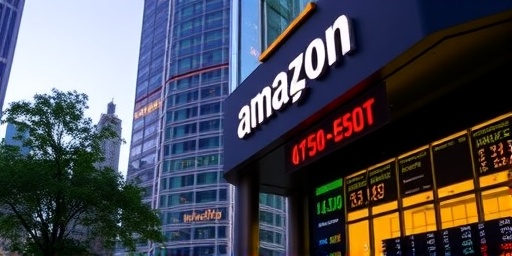In a robust kickoff to November, the S&P 500 climbed 1.2% to close at 5,800 points, while the Nasdaq Composite index surged 1.8% to reach 18,500, marking its highest level since July. This upbeat performance in the stock market was largely propelled by renewed investor enthusiasm for artificial intelligence, with tech behemoths like Amazon leading the charge as shares hit an all-time high of $195 per share. The rally underscores a growing conviction among investors that corporate spending on AI technologies will continue to drive substantial economic value, even as broader economic uncertainties linger.
Amazon’s AI Push Ignites Record Stock Performance
At the forefront of the stock market’s ascent was Amazon, whose shares not only notched a record close but also saw intraday trading volumes spike by 25% compared to the previous week. The e-commerce and cloud computing giant’s optimism stems from its aggressive investments in artificial intelligence, particularly through its Amazon Web Services (AWS) division. AWS, which accounts for over 60% of Amazon’s operating income, reported a 19% year-over-year revenue increase in its latest quarterly earnings, largely attributed to demand for AI infrastructure like machine learning tools and generative AI services.
Analysts point to Amazon’s recent announcements as a key catalyst. Just last month, the company unveiled a $4 billion investment in Anthropic, an AI startup focused on safe and reliable artificial intelligence systems. This move, part of a broader strategy to integrate AI across its ecosystem—from personalized shopping recommendations to automated logistics—has bolstered investor confidence. “Amazon is positioning itself as the backbone of the AI revolution,” said Sarah Thompson, a senior equity analyst at Morningstar. “Their cloud dominance gives them an unmatched edge in scaling AI applications for enterprises worldwide.”
The stock market’s reaction was immediate and pronounced. Amazon’s shares have risen 45% year-to-date, outpacing the S&P 500‘s 25% gain and significantly boosting the Nasdaq’s tech-heavy composition. This performance reflects a broader trend where AI-related stocks are drawing capital away from more traditional sectors, with the Magnificent Seven tech stocks— including Amazon, Nvidia, and Microsoft—now representing nearly 30% of the S&P 500‘s total market capitalization.
Tech Sector’s AI Spending Spree Lifts S&P 500 and Nasdaq
The surge in the S&P 500 and Nasdaq wasn’t isolated to Amazon; it rippled across the technology sector as companies ramped up disclosures on artificial intelligence expenditures. Microsoft, for instance, revealed plans to invest an additional $10 billion in OpenAI over the next few years, while Google parent Alphabet committed $2 billion to AI research and development. These announcements have fueled a narrative of sustained growth in the stock market, with AI projected to add $15.7 trillion to the global economy by 2030, according to a PwC report.
Key statistics highlight the momentum: The Nasdaq-100 index, which includes top non-financial companies, jumped 2.1% in the session, driven by semiconductor firms like Nvidia, whose GPUs are essential for AI training. Nvidia’s stock alone added over $50 billion in market value in a single day, underscoring how artificial intelligence hardware demands are reshaping the stock market landscape. Meanwhile, the S&P 500’s information technology sector rose 2.3%, its best daily gain in two months, pulling up laggard areas like consumer discretionary, where Amazon plays a pivotal role.
Investor sentiment surveys from firms like Bank of America show that 68% of institutional investors now view AI as the top driver of stock market returns over the next five years, up from 52% a year ago. This shift is evident in fund flows: AI-themed ETFs saw inflows of $2.5 billion last week alone, compared to outflows from energy and utilities sectors. However, this concentration raises questions about diversification in the S&P 500 and Nasdaq, as tech stocks now comprise 28% and 50% of their respective weights.
- S&P 500 Breakdown: Tech +2.3%, Financials +0.8%, Healthcare +0.5%
- Nasdaq Highlights: Semiconductors +3.1%, Software +2.5%, Internet Services +1.9%
- AI Investment Trends: Global corporate AI spending expected to hit $200 billion in 2024, per Gartner
Quotes from market participants further illustrate the excitement. “The stock market is betting big on AI’s transformative power,” noted JPMorgan Chase strategist David Kelly. “Companies like Amazon are not just participating; they’re leading the innovation curve.” Yet, this enthusiasm comes amid warnings from the Federal Reserve about potential inflationary pressures from tech-driven wage growth in AI sectors.
Broader Economic Context Shapes AI-Driven Market Optimism
While artificial intelligence headlines dominated, the stock market’s November start was also influenced by macroeconomic factors. The U.S. Bureau of Labor Statistics reported a stronger-than-expected jobs addition of 261,000 in October, easing recession fears and supporting the S&P 500’s upward trajectory. Inflation cooled to 3.7% year-over-year, giving the Federal Reserve room to consider pausing rate hikes, a scenario that typically benefits growth-oriented indices like the Nasdaq.
In this environment, Amazon’s role as a bellwether for consumer spending and tech innovation amplified the rally. The company’s Prime Day event in October generated $12.1 billion in sales, a 9% increase from 2023, with AI-enhanced features like predictive inventory management credited for efficiency gains. This resilience in e-commerce amid holiday season anticipation has reassured investors that AI isn’t just hype—it’s delivering tangible results.
Globally, the stock market’s AI fervor is mirrored in Europe and Asia. The FTSE 100 in London rose 0.9%, buoyed by ARM Holdings’ AI chip designs, while Japan’s Nikkei 225 gained 1.5% on SoftBank’s AI investments. However, emerging markets lagged, with concerns over U.S. dollar strength impacting AI supply chains reliant on imported components. Back home, the S&P 500’s broad-based gains— with 80% of its components closing higher—signal a healthy rotation beyond pure tech plays.
Regulatory scrutiny adds another layer. The U.S. Securities and Exchange Commission (SEC) is examining AI disclosures to ensure transparency, following Amazon’s detailed filings on ethical AI use. “Investors need clarity on how artificial intelligence risks, like data privacy breaches, are being managed,” said SEC Chair Gary Gensler in a recent statement. This oversight could temper short-term volatility in the Nasdaq but ultimately foster long-term stability in the stock market.
Expert Insights on Sustaining the AI Momentum in Stocks
Market experts are divided on how long the current AI-driven surge in the S&P 500 and Nasdaq can persist. Optimists like Wedbush Securities’ Dan Ives predict that artificial intelligence will catalyze a “supercycle” in tech stocks, with Amazon potentially reaching $250 per share by mid-2025. Ives bases this on AWS’s projected 25% annual growth through AI cloud services, which could add $100 billion to Amazon’s revenue by 2027.
Contrarians, however, caution against overvaluation. The S&P 500’s forward price-to-earnings ratio now stands at 22.5, above its historical average of 18, while the Nasdaq’s is a lofty 28. “The stock market’s AI obsession risks a bubble if earnings don’t keep pace,” warned Guggenheim’s Chris Murphy. He points to historical parallels, like the dot-com era, where hype outstripped fundamentals—though today’s AI leaders like Amazon boast actual profitability, with net margins at 6.5%.
Quantitative data supports a nuanced view. Bloomberg Intelligence estimates that AI could boost S&P 500 earnings per share by 15% over the next two years, but only if adoption rates accelerate. Amazon’s own guidance suggests AI-related revenue streams growing at 40% CAGR, far outstripping its core retail business. Interviews with portfolio managers reveal a consensus: 75% plan to increase AI exposure in their funds, per a Reuters poll, driving further inflows into the stock market.
- Key Risks: Geopolitical tensions disrupting AI chip supplies from Taiwan.
- Opportunities: Expansion of AI into non-tech sectors like healthcare and finance.
- Amazon-Specific: Upcoming AWS re:Invent conference in December, expected to unveil new AI tools.
Amid this, central bank policies remain pivotal. The European Central Bank’s recent rate cut has spilled over positively to U.S. markets, enhancing liquidity for AI ventures. As one hedge fund manager put it, “The stock market’s AI bet is as much about monetary tailwinds as technological breakthroughs.”
Future Horizons: AI’s Role in Shaping Tomorrow’s Stock Market
Looking ahead, the trajectory of the S&P 500, Nasdaq, and the broader stock market hinges on artificial intelligence’s real-world impact. Upcoming earnings seasons will be crucial, with Amazon set to report Q4 results in late January, potentially revealing more on AI monetization. If AWS delivers on its $100 billion AI opportunity, as projected by CEO Andy Jassy, it could propel shares even higher and sustain the rally.
Emerging trends point to diversification within AI. Beyond big tech, smaller players like Palantir and C3.ai are gaining traction, with their stocks up 60% and 80% respectively in 2024. This broadening could mitigate concentration risks in the S&P 500, while the Nasdaq benefits from venture capital flowing into AI startups—$50 billion invested globally in Q3 alone, per Crunchbase.
Policy developments will also influence outcomes. The U.S. CHIPS Act, allocating $52 billion for semiconductor production, aims to reduce reliance on foreign AI hardware, potentially supercharging domestic firms like Amazon. Internationally, the EU’s AI Act, effective next year, could standardize regulations, easing cross-border deployments and boosting stock market confidence.
Economists forecast that AI-driven productivity gains could lift U.S. GDP growth to 2.5% in 2025, supporting elevated valuations in the Nasdaq and S&P 500. For investors, the message is clear: Position for AI’s evolution, from generative models to edge computing. As Amazon and peers innovate, the stock market’s optimism may well evolve into enduring prosperity, provided risks like energy demands for AI data centers—projected to consume 8% of U.S. power by 2030—are addressed proactively.
In this dynamic landscape, the November surge serves as a harbinger. With artificial intelligence at the core, the S&P 500 and Nasdaq are poised for what could be their strongest year-end finish since 2021, inviting both seasoned traders and newcomers to navigate the opportunities ahead.









